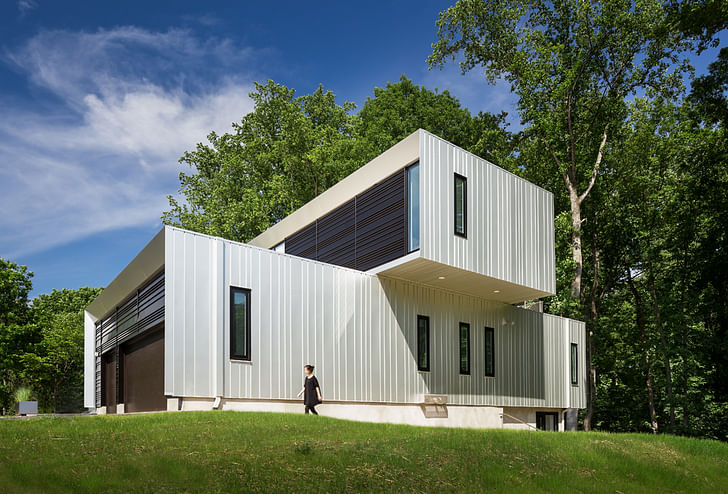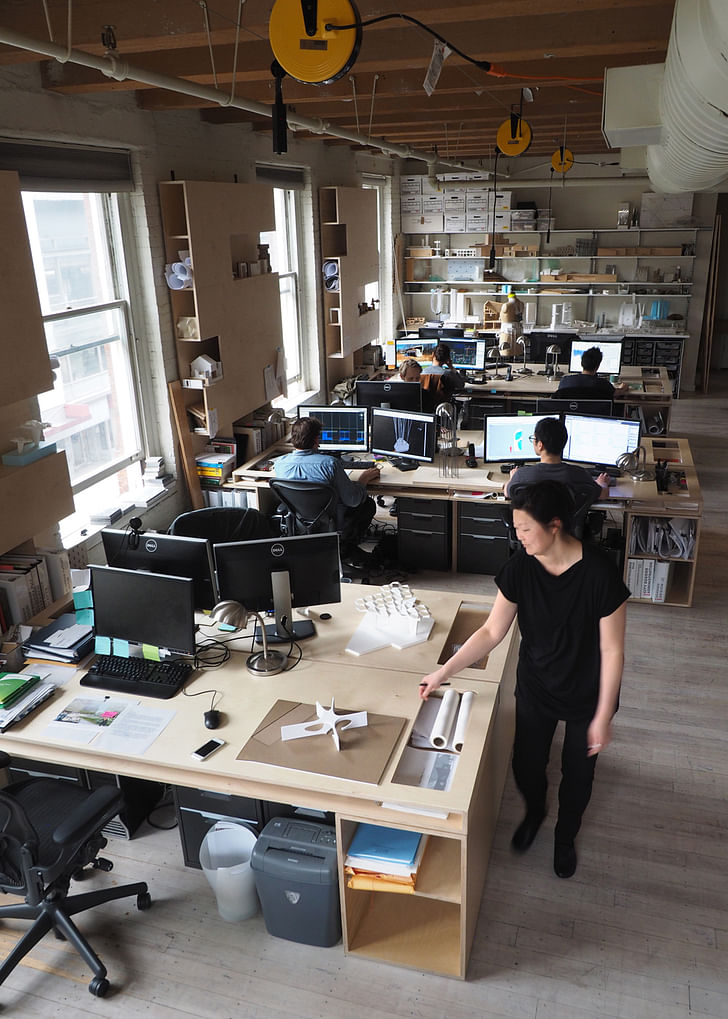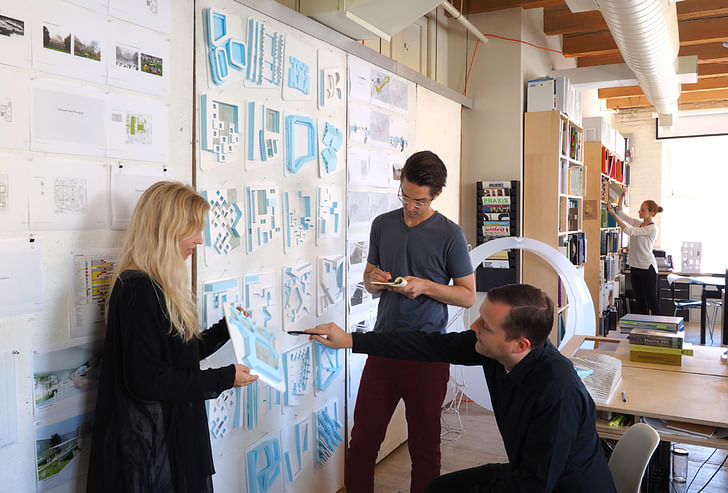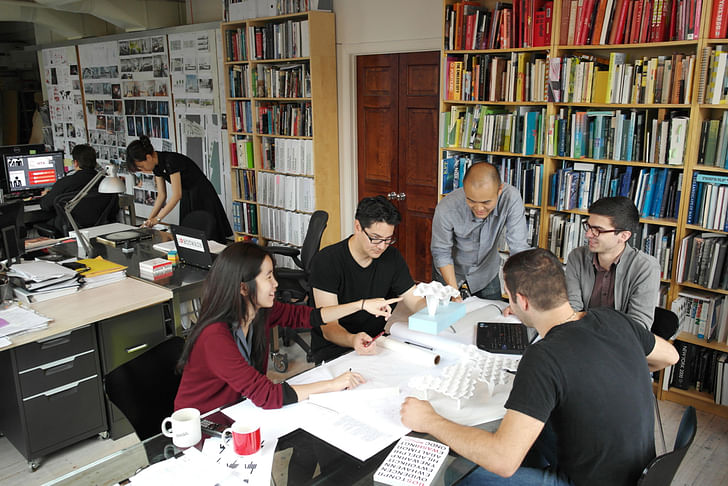
What's working as an architect actually like? Even for students on track to become one, the answer isn't always clear or forthcoming, and for those outside the industry, common ideas about architecture rarely reflect its reality. In our "The Life of a New Architect" series, three young architects (two designers and one licensed architect) discuss their transition from student to professional, their changed perceptions of the career and the challenges and joys of their current work.
Eric Höweler occupies an enviable position as an architect. Nineteen years into his career, he's a principal at a burgeoning firm that he co-founded with his spouse Meejin Yoon and that's won the admiration of critics through the firm's expansive take on architecture. In 2011 Höweler + Yoon Architecture won the Boston Society of Architect's competition to design their new headquarters, and in 2012 the firm took Audi's Urban Future Award for its reimagining of the transportation infrastructure of BosWash, the metropolitan span that runs from Washington, D.C. to Boston. With projects that range from art installations and furniture to residences and large corporate retreats, Höweler + Yoon is the kind of firm many architecture students aspire to work for or dream to start themselves one day.


Yet for Eric and Meejin, behind the accumulating projects and accolades is the more prosaic burden of running the firm.
"In school everyone wants to be designers and have their own practice, but what most students don't connect is that having a practice is also being a businessman or woman – that you have to run a business which includes finding work, negotiating contracts and building consensus among people from different fields," says Eric.
Much of running a firm is about finding work. "How do you find work? That's the million dollar question," as Eric puts it. Though nine years have passed since Eric and Meejin started H + What most students don't connect is that having a practice is also being a businessman or woman"Y, they still don't know from where the next project will come. Most work comes by word of mouth. Frequently, clients seek them out after seeing a previous project in a publication, yet the process is haphazard at best.
As part business strategy and firm ethos, H + Y takes on a spectrum of work, guided by an exuberant inquisitiveness that blurs the lines between art, architecture, technology and material. Their interest lies in the "conditions of the spatial environment," a definition of architecture that expands the traditional scope of the discipline to include the design of everything from skyscrapers to clothing. This approach to architecture has opened a variety of work to the firm and helped Eric and Meejin take projects they're interested in rather than taking projects "just for the fees."
However, while freeing, non-specialization does not absolve H + Y from what can be the constant financial wager that is running a firm. For smaller and mid-sized firms, this plays out in the balance between the amount of work available and the size of the firm. More firm staff equals a greater ability to take on projects and generate revenue when projects are available. However, the more staff on hand, the more people who need to be paid, a problem should the construction market slow and the funding for projects dry up.
Competitions, a common source of attractive work, can also present financial gambles. With the weeks of work that competitions often require, if the firm does not win the competition, and subsequently the pay that comes with it, they may not have the ability to pay their employees for their work. The at times high-stress management of expenses, projects and HR for smaller firms like H + Y falls in the lap of the principals.
It's hard to be a young architect because no one wants to take risks on you. There's a lot of liability on a project, a lot of risks, so clients want someone with experience."Prior to establishing Höweler + Yoon, Eric was free of the managerial duties and had a larger role in designing and drawing. He began his architecture career at Kohn Pedersen Fox Associates in New York City after graduating with his masters in architecture from Cornell in 1995. He spent seven years at the firm, eventually rising to associate principal. In his first three years, Eric didn't see a site or a client or any of his designs built. He and the architects he was working with would finish up a set of drawings and then ship them off to China where most of their sites were.
"It's definitely hard [starting out in the career]. You're relegated to designing bathrooms or parts of the lobby." Though, "it's a powerful moment when you first see something you designed built." New challenges await architects when they become licensed and choose to work for themselves. "It's hard to be a young architect because no one wants to take risks on you. There's a lot of liability on a project, a lot of risks, so clients want someone with experience."

By the time Eric rose to associate principal at KPF, he was flying to London to look at materials or flying to Hong Kong to meet with clients. The firm's principals managed the business side of operations; Eric's job was to just be an architect. In 2002, Diller Scofidio + Renfro brought Eric to their firm to help design the new facility for Boston's Institute of It's easy to feel distanced from the work. You have to trust your staff."Contemporary Art. At that time Diller Scofidio consisted of twelve people and "had a sense of humor." "They were intellectual," Eric recalls.
Diller Scofidio's family atmosphere was a marked contrast to KPF. Unlike the stiff hierarchy of a large firm, at a small firm everyone has office responsibilities beyond their role as architects or designers. At Diller Scofidio everyone had chores. Eric's was taking out the trash. Also lunch duties rotated among employees weekly, so even if someone had been up all night completing a project before a deadline, if it was their turn to prepare lunch, he or she would have to find time to run out and buy sandwich fixings and salad for the rest of the firm.


When Eric and Meejin started H + Y in 2005, the firm consisted of three people, and everyone had a hand in completing the set of drawings for a project and building the models. Now with a growing staff of architects at the firm, Eric's time is spent talking to clients in meetings, writing proposals and project descriptions, responding to emails, and meeting the reality of the work is super social ... you have to build consensus as an architect as well as seduce the client and get people to follow you.with the firm's project architects to get up to speed on their work. As a principal in a small firm, "you feel pulled in many directions,” he says. "It's easy to feel distanced from the work. You have to trust your staff."
Rather than design chops or pure creativity, much of architecture is about communication. It's the less glamorous reality that doesn't always fit with ideas of the career held by both outsiders and newcomers to the career.
For Eric, architecture students' greatest misperception of the career is the belief that architecture is individualistic, the province of solitary geniuses. "In school you're trained as an individual, but the reality of the work is super social. Architecture requires political skills, social skills, negotiation skills – you have to build consensus as an architect as well as seduce the client and get people to follow you."

Eric has learned this reality in his own career and admonishes his students (he teaches at Harvard's Graduate School of Design) to know their audience when presenting their ideas. He admits that he's still learning too. "In architecture, they say you're middle-aged until you're 60." Looking forward, Eric would love to have H + Y considered for larger projects, and while he's happy with the success of the firm, he'd like at some point to get back to doing more of the "fun stuff" – the drawing and modeling.
I write, travel and take pictures. My interests include design, identity and natural and urban landscapes.
9 Comments
Sean you are on a roll, good stuff.
great article. if they really want in on the fun stuff, they should lose the black attire. they're architects, not undertakers.
Took a class by Meejin Yoon last semester!! She is great!!
Sean, get some sleeves
I agree with xray. Why are Architects dressing in black like “hair stylists” ?
On a more serious note... how do you managed to open your own office? It’s requires tons of money!
Rent, computers, computer programs, employees salaries, and so much more!
For many years since graduation I was boxed by interviewers as a cad person to be a construction documents production... in the back room. I hated every second of it! I never got any support to complete the requirements for internship to achieve licensure.
After many wasted years, I became licensed in Europe.
If you have millions $ to run your office, then you have enough to build your own designs. Even more, you can retire early instead of paying salaries and all that.
I have seen some Architects couples in my working time, where the husband is the only one with license.
I do appreciate the openness of the article. I, as many, can relate to it. It is true, schools do not prepare you for it in the honest way (in the USA at least). But I don’t know what YOU are complaining about. You worked for good offices, you went to an elite university, and you teach at Harvard, on top of having your own firm! Imagine those people who didn’t go to recognized schools and don’t teach even at southern schools! You can make a good living just by being a Harvard professor and have the recognition that comes with that. You just don’t see how lucky you really are!
It would be great to know how these and others financed starting up a practice and then scaling it up. Do their teaching jobs provide access to health insurance and a steady paycheck to relieve some of the need to live off of the firm's earnings? To what extent does family wealth play a role in funding some of today's cool young firms? These things are rarely, if ever, taught in USA architecture schools.
Block this user
Are you sure you want to block this user and hide all related comments throughout the site?
Archinect
This is your first comment on Archinect. Your comment will be visible once approved.